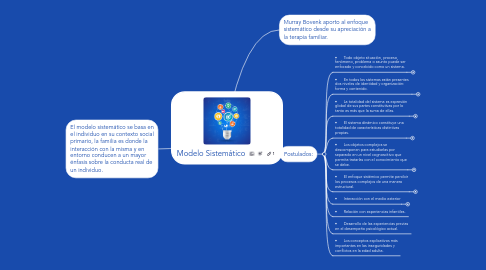
1. El modelo sistemático se basa en el individuo en su contexto social primario, la familia es donde la interacción con la misma y en entorno conducen a un mayor énfasis sobre la conducta real de un individuo.
2. Murray Bovenk aporto al enfoque sistemático desde su apreciación a la terapia familiar.
3. Postulados:
3.1. • Todo objeto situación, proceso, fenómeno, problema o asunto puede ser enfocado y concebido como un sistema.
3.1.1. Situational Analysis / Drivers
3.1.1.1. What is driving us to do this?
3.1.1.2. SWOT Analysis
3.1.1.2.1. Strengths
3.1.1.2.2. Weaknesses
3.1.1.2.3. Opportunities
3.1.1.2.4. Threats
3.1.1.3. Customer Findings - What have we learned from customers?
3.1.2. Competitive Analysis
3.1.2.1. Do we have competitors and threats in these target markets with the proposed offerings?
3.1.2.2. What are our competitors doing and how are they positioning?
3.1.2.3. How do we position against each competitor?
3.1.3. Target Customer(s)
3.1.3.1. Buyer Profile
3.1.3.1.1. Title
3.1.3.1.2. Industry
3.1.3.1.3. Geography
3.1.3.1.4. Business Size
3.1.3.2. Influencer Profile
3.1.3.3. User Profile
3.1.3.4. What do customers want and need?
3.1.3.5. What business problems do each of these customers have?
3.1.4. Customer Segmentation
3.1.4.1. Which customers or sets of customers do we sell to?
3.1.4.2. What are the target market segments that we want to go after?
3.1.4.3. What are the distinct problems for each segment of the market?
3.1.5. Total Available Market
3.1.5.1. New Prospects
3.1.5.1.1. How much of each target segment have we penetrated?
3.1.5.1.2. How much opportunity is available in each target segment?
3.1.5.2. Existing Customers
3.1.5.2.1. Can we up-sell existing customers?
3.2. • En todos los sistemas están presentes dos niveles de identidad y organización: forma y contenido.
3.2.1. Service Offer
3.2.1.1. What are we selling?
3.2.1.2. Product Definition
3.2.1.3. Pricing
3.2.1.4. Packaging
3.2.1.5. Positioning
3.2.2. Value Proposition
3.2.2.1. What is the Value Proposition to the Customer?
3.2.2.2. What pain are we solving?
3.3. • La totalidad del sistema es expresión global de sus partes constitutivas por lo tanto es más que la suma de ellas.
3.3.1. Revenue Forecasts
3.3.1.1. Revenue and P&L Forecast (5 Years)
3.3.1.2. Revenue should be split out quarterly
3.3.2. Cost Analysis
3.3.2.1. Should include a description of the costs in entering this business and profitability analysis
3.3.3. Profitability Analysis
3.3.3.1. P&L for the offer to include gross margin, net income and break even analysis.
3.4. • El sistema dinámico constituye una totalidad de características distintivas propias.
3.4.1. Sales Strategy
3.4.1.1. Direct Sales Strategy
3.4.1.2. Inside Sales Strategy
3.4.1.3. Channel Sales Strategy
3.4.2. Partner Strategy
3.4.2.1. Channel Strategy
3.4.2.1.1. What 3rd party channels should we consider for reselling this service?
3.4.2.2. Technology Partnerships
3.4.2.2.1. What technology vendors (if any) do we need to work with to execute on this plan?
3.4.2.3. Solutions Partners
3.5. • Los objetos complejos se descomponen para estudiarlas por separado en un nivel cognoscitivo que permita tratarlas con el conocimiento que se debe.
3.5.1. Positioning & Messaging
3.5.1.1. What is the key messaging and positioning for the service offer? (Pain, alternatives, solution)
3.5.1.2. How do we communicate internally?
3.5.1.3. How do we communicate externally?
3.5.2. Promotion Strategy
3.5.2.1. Marketing Programs (Installed base versus new prospects)
3.5.2.2. Advertising (Publications, etc.)
3.5.2.3. Analyst Relations (Target Analysts)
3.5.2.4. Public Relations
3.5.2.5. Events (Trade shows, SEO/SEA, Seminars)
3.5.2.6. Webinars
3.5.3. Demand Generation & Lead Qualification
3.5.3.1. How do we generate and qualify new leads for the target offer?
3.5.3.2. Prospect Lists
3.5.3.3. Key Questions to Ask
3.5.3.4. Sales Collateral
3.5.3.5. Presentations
3.5.3.6. Data Sheets
3.5.3.7. White Papers
3.5.3.8. ROI Tools
3.5.3.9. Other Sales Tools (web site, etc.)
3.6. • El enfoque sistémico permite percibir los procesos complejos de una manera estructural.
3.6.1. Numbers, budget, waterfall, break-even (cost>leads>trials>deals)
3.6.2. Sales Programs
3.6.3. Accelerated Learning Strategy, Controls, Metrics
3.6.4. Include feedback loops
3.6.5. Include financial metrics (definition of success)
3.6.6. Pipeline reports, etc…
3.7. • Interacción con el medio exterior
3.7.1. M&A?
3.7.2. Risk Analysis & Mitigation
